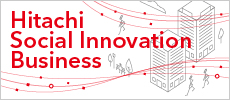System IntegrationDigital Systems & Services
1. Finance DX Service for Financial Institutions Leading the Digital Shift in Loan Transaction Handling
The accelerating shift to digital technology over recent years has increased interest in the digitalization of loan transactions at financial institutions. A finance DX service for financial institutions released by Hitachi in July 2023 provides comprehensive digitalization of procedures for dealing with a wide range of the stakeholders involved in such loan transactions, not just those that the institution trades with directly. Whether it is commercial finance for business customers (including loans backed by a credit guarantee association) or the offering of mortgages or unsecured loans to retail customers, the service allows for rapid rollout in accordance with the institution’s digital strategy, allowing them to start on a small scale that focuses on the high-priority processes from applying for finance to managing the loan after it is approved. The service also features an application programming interface (API) infrastructure that facilitates linkage with private-sector financial services.
The service has been evaluated by a variety of financial institutions, with 16 companies having chosen to adopt it as of March 2025. Future plans involve further expanding the scope of its business process functions for loan transactions while also extending the service to cover other activities. By doing so, Hitachi aims to provide a boost for the digital transformation (DX) of financial transactions and to deliver services that drive the digital shift in how these transactions are handled in Japan.
2. Expansion of Digital Channels Utilizing Microservices Platform
In an increasingly digitalized world, it is becoming more important than ever to enhance experience value for customers through seamless integration of real-world and digital channels achieved by DX implementation and use of the latest technologies to adapt rapidly to changes in customer lifestyles.
It is against this background that Hitachi has built a common application platform for banking that allows for use across all the different channels. The system utilizes Hitachi Microservices Platform and incorporates a microservices framework from GlobalLogic.
The common application platform features a seamless configuration that deals with business processes as fine-grained microservices and allows for flexible functional enhancement such as improvements in usability or linkage with external services. Efficiency of use and ease of maintenance are also enhanced by identifying function duplication across different systems and enabling standardized use of the highly independent microservices, which are hosted on the cloud. The platform also makes a major contribution to business improvement, using cloud-native practices running on a public cloud to enable dynamic system development with rapid implementation to deal with changes in increasingly diverse customer needs or to enhance experience value. The goal for the future is to expand the use of digital channels with a view to extending the scope of the platform beyond banking.
3. Professional Human Resources Visualization and Training Solution that Accelerates Organizational and Individual Growth
In today’s rapidly diversifying business environment, effective professional development is essential for improving corporate performance and sustaining competitiveness. Mitsubishi UFJ Morgan Stanley Securities Co., Ltd. and Hitachi have jointly developed a groundbreaking solution for visualizing and training professional human resources to address this need.
The solution offers personalized development plans and provides a comprehensive overview of each professional’s skills, career trajectory, and key performance indicators such as business targets. Companies can use the platform to set development goals aligned with workplace needs and tailor training to suit the unique requirements of each department. The aim is to enhance individual growth and motivation while driving overall organizational performance.
Mitsubishi UFJ Morgan Stanley Securities has already implemented the solution within its sales divisions, resulting in improved sales capabilities and other performance gains.
Looking ahead, the plan is to expand the solution’s reach across a wide range of industries, positioning it as a key tool to support sustainable corporate growth.
[03]Fostering Professional Development by Highlighting Human Resource Needs![[03]Fostering Professional Development by Highlighting Human Resource Needs](/rev/archive/2025/01/02/image/fig_03.png)
4. Full-scale Application of Generative AI through Collaboration of Mitsubishi HC Capital and Hitachi
Hitachi and Mitsubishi HC Capital Inc. have been collaborating to introduce the routine use of generative artificial intelligence (AI) for approximately 2,200 Mitsubishi HC Capital staff. The goal is to improve the productivity of sales and other activities.
Along with rapid advances in generative AI and its growing adoption in business, the project is also conscious that commercial use of the technology poses challenges that include, security, privacy, and the accuracy of AI responses.
Hitachi has overcome these challenges by establishing guidelines and a secure environment for using the technology on Azure* OpenAI Service*1), also contributing knowledge in the form of expertise and use cases held by its Generative AI Center that is home to specialists in the field.
The two companies are also engaging in joint planning and the formulation of new measures for realizing the benefits of the system, including putting use cases into practice, establishing a knowledge database, and developing a medium- to long-term roadmap that anticipates interoperation with other systems.
- *1
- A service for using OpenAI’s AI on a Microsoft Azure cloud platform.
5. Collaboration between Joyo Bank and Hitachi on CO2 Emissions Management for Small and Medium-sized Businesses
Joyo Bank, Ltd. and Hitachi embarked in June 2024 on a collaboration to expand support for the decarbonization efforts of small and medium-sized businesses, their aim being to facilitate the sustainable growth of regional communities. The initiative led to Joyo Bank’s launch in July 2024 of the “EcoSapo” service for calculating and managing CO2 emissions at small and medium-sized local businesses.
EcoSapo is a cloud service for such businesses that uses Hitachi’s EcoAssist-Enterprise environmental information management service. By entering their information into a purpose-designed Excel* spreadsheet, users can view information on their CO2 emissions, track emission trends, monitor progress toward reduction targets, and manage their reduction plans. In addition to making use of the displayed emissions data to set their own reduction targets, the service also provides users with comprehensive support that extends to solutions for developing plans to reduce CO2 emissions in their supply chains and for putting these plans into action.
6. Cross-industry Subsurface Visualization Service for Maintenance of Underground Infrastructure
One of the challenges in the provision of underground infrastructure is when difficulties arise that prevent pipes from being installed or upgraded in a planned and efficient manner. These include the time and effort spent on design work that requires the collection and collation of drawings held separately by the various organizations involved and the design changes, work interruptions, and damage to pipes that occurs when the actual situation does not match the drawings.
To overcome these problems, Hitachi’s subsurface visualization service helps provide a more accurate and intuitive way to determine the location of underground pipes. More than 50 instances of the service have been supplied, either on a trial or a service delivery basis, to customers in a range of industries, most notably those organizations involved in maintaining underground infrastructure (as of October 2024).
The service uses a ground-penetrating radar system for the non-destructive scanning of underground pipe locations. The scan data is analyzed and information about underground pipes consolidated on a centralized platform. As viewing of two- or three-dimensional data in a web browser provides an accurate and intuitive view of the condition and location of underground infrastructure, not only does it improve design accuracy, including where pipes are laid, but it also minimizes risks such as design changes, work interruptions, and damage to pipes.
[06]Overview of Subsurface Visualization Service![[06]Overview of Subsurface Visualization Service](/rev/archive/2025/01/02/image/fig_06.png) 2D: two dimensional
2D: two dimensional
3D: three dimensional
* Imaging of cavities and other underground objects is to become available on a future version of the subsurface visualization platform.
7. Upgrade of Steel Plant Computer Systems through Virtualization
[07]System Configuration with Parallel Execution![[07]System Configuration with Parallel Execution](/rev/archive/2025/01/02/image/fig_07.png) RDP: remote desktop protocol
RDP: remote desktop protocol
VM: virtual machine
HMI: human machine interface
The trend toward system virtualization has reached control systems for steel plants and Hitachi has developed a virtualized plant control system to meet this need. The main features are as follows.
- Building on Hitachi’s own autonomous distributed architecture, the product provides concurrent execution on a virtualization-enabled control server without any modifications to the systems being upgraded. This simplifies the work and reduces the time required for upgrading.
- Whereas the existing system had a redundant configuration of online and offline servers, with the offline server able to be used either as an analysis server or as a backup, the ability of virtualization to run multiple instances enhances convenience and reliability by allowing both roles to be fulfilled at the same time.
- Configuring clients as well as servers to run on the virtualization server allows for the use of thin clients with optimized allocation of virtual machine resources such as central processing units (CPUs), memory, and disks. Maintenance is also enhanced by the centralized collection of logs and the ability to analyze them all in one place if a problem arises.
(Commencement of operation of initial system planned for January 2025)
8. Guidance Support System for People with Mobility Restrictions
In public transportation, the demand for mobility support from users who require assistive devices such as wheelchairs or white canes is on the rise.
To address this need, in 2022, Hitachi began offering a system in a software as a service(SaaS) format, that enables the completion of tasks such as communication and handovers between staff members, as well as managing records of boarding and disembarking support, entirely through smart devices.
This system has been implemented by eight railway operators, and contributes to creating an environment where public transportation can be used safely and securely while also improving staff work efficiency and reducing psychological burden.
In 2024, functions were added to “further operational efficiency,” “improve services through coordination among operators,” and “strengthen user touchpoints.”
Japan’s transportation network involves close coordination among multiple operators to provide transportation services, making it challenging for individual operators to improve efficiency independently.
As a SaaS provider, Hitachi leverages its network to build services that benefit both users and operators by actively supporting “improving services through coordination among operators,” focusing on features such as mutual through-operation and transfer coordination functions that extend beyond railway operators.
[08]Overview of Guidance Support System for People with Mobility Restrictions![[08]Overview of Guidance Support System for People with Mobility Restrictions](/rev/archive/2025/01/02/image/fig_08.png) MaaS: mobility as a service
MaaS: mobility as a service

![[01]Overview of Finance DX Service for Financial Institutions](/rev/archive/2025/01/02/image/fig_01.png)
![[02]Overview of Common Application Platform](/rev/archive/2025/01/02/image/fig_02.png)
![[04]Project Overview](/rev/archive/2025/01/02/image/fig_04.png)
![[05]Overview of EcoSapo Service](/rev/archive/2025/01/02/image/fig_05.png)


